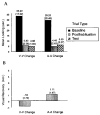Intersensory redundancy guides attentional selectivity and perceptual learning in infancy
- PMID: 10749076
- PMCID: PMC2704001
- DOI: 10.1037//0012-1649.36.2.190
Intersensory redundancy guides attentional selectivity and perceptual learning in infancy
Abstract
This study assessed an intersensory redundancy hypothesis, which holds that in early infancy information presented redundantly and in temporal synchrony across two sense modalities selectively recruits attention and facilitates perceptual differentiation more effectively than does the same information presented unimodally. Five-month-old infants' sensitivity to the amodal property of rhythm was examined in 3 experiments. Results revealed that habituation to a bimodal (auditory and visual) rhythm resulted in discrimination of a novel rhythm, whereas habituation to the same rhythm presented unimodally (auditory or visual) resulted in no evidence of discrimination. Also, temporal synchrony between the bimodal auditory and visual information was necessary for rhythm discrimination. These findings support an intersensory redundancy hypothesis and provide further evidence for the importance of redundancy for guiding and constraining early perceptual learning.
Figures



References
-
- Allen TW, Walker K, Symonds L, Marcell M. Intrasensory and intersensory perception of temporal sequences during infancy. Developmental Psychology. 1977;13:225–229.
-
- Bahrick LE. Infants’ perception of substance and temporal synchrony in multimodal events. Infant Behavior and Development. 1983;6:429–451.
-
- Bahrick LE. Infants’ intermodal perception of two levels of temporal structure in natural events. Infant Behavior and Development. 1987;10:387–416.
-
- Bahrick LE. Intermodal learning in infancy: Learning on the basis of two kinds of invariant relations in audible and visible events. Child Development. 1988;59:197–207. - PubMed
-
- Bahrick LE. Infants’ perceptual differentiation of amodal and modality-specific audio-visual relations. Journal of Experimental Child Psychology. 1992;53:180–199. - PubMed

